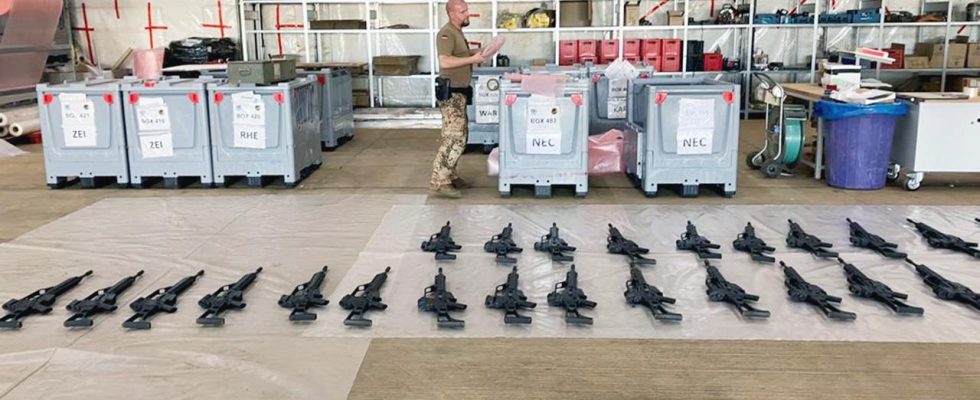background
The Bundeswehr still has to bring 700 soldiers and 600 containers of material safely home from Mali. A Herculean task, and the time for it is extremely short.
From the radio to the Fuchs transport tank – all the material for the return journey to Germany is prepared in a gigantic hall at the Bundeswehr camp in Gao in Mali.
Anyone who enters this so-called “material lock” is almost reminded of an operating room: pistols are so neatly disassembled into their individual parts and laid out on foil.
Armored vehicles are so thoroughly cleaned with disinfectant and thus impregnated against animal diseases that one can hardly imagine how, until recently, the reddish desert sand of Mali was trickling out of every crack.
Spreading terrorist groups
A soldier is carefully wrapping G36 assault rifles in shockproof bubble wrap and storing them in specially secured boxes. The G36 – like all weapons – is subject to priority one. This means: On the logisticians’ scale of importance, which ranges from one to five, it is at the top and must be returned to Germany.
The Bundeswehr wants to avoid at all costs that radios, weapons or armored vehicles fall into the hands of expanding terrorist groups after the withdrawal. Or even come into the possession of Russian mercenaries who fight on the side of the Malian army.
The Bundeswehr wants to avoid at all costs that radio devices, armored vehicles or weapons end up in the “wrong hands” after the withdrawal.
“No three-lane highway”
It’s about reconciling the necessary caution with the extremely high time pressure: “The schedule is ambitious. Not much can go wrong, in fact nothing can go wrong,” says Commander Heiko Bohnsack in the ARD-Interview too. “We don’t have a three-lane highway here on which we can drive our forces and our material home.”
Instead of a highway, there is an airfield in Gao, located directly in front of the German camp. Since the air route is the safest, the Germans and their A400M transport aircraft urgently need this exit door, this exit, to remain open for them:
“Gao Airport is the biggest bottleneck,” says Thomas Henschke, director of material relocation. Henschke’s main problem: There is a lot, too much, that he has difficulty influencing. If the weather or the Malian authorities don’t cooperate, the schedule will be thrown into disarray.
The air route out of Mali is the safest. The Germans therefore urgently need this exit door to remain open.
Effects of the Security situation
A good ten days ago, a completely overloaded Russian Ilyushin plane from the Malian army touched down too late at the airport in Gao, rolled over the runway and exploded on the red gravel runway behind it.
And then there are the fierce fighting between the Malian army and terrorist groups. Logistics expert Henschke explains that we are definitely dependent on the security situation: “Not because we are an immediate target, but because of the possible effects that battles here on site can have on our logistics.”
After a bloody suicide attack at the beginning of September on a Malian army base just a few hundred meters from the German camp, flights were temporarily stopped for obvious reasons.
Readiness until the end
Henschke and his team cannot do anything about the worsening situation outside. But it can certainly help ensure that the soldiers in the German camp can continue to protect themselves until the last minute: “That also means that we don’t bring home the material with the highest priority, i.e. our combat vehicles and weapons, first . But that combat vehicles and weapons will be here until the end.”
And so this withdrawal remains a balancing act until the last minute: on the one hand, it is important to bring the material of importance level one home safely – but on the other hand, to always have enough on site so that the troops do not become vulnerable.
In the middle of the Bundeswehr camp is what is probably the most expensive shell in the region: the federal government has already spent more than 26 million euros on the clinic.
Unfinished hospital remains
By the way, what will definitely remain behind is the shell of a hospital in the middle of the Bundeswehr camp. Anyone who enters the building is surprised at how far they have come: the sinks and disinfectant bottle holders are already hanging in front of the operating rooms, yellow LAN cables have been laid, and the roof and walls are secured against rocket fire.
The federal government had already spent more than 26 million euros on the clinic when the decision was made at the beginning of the year not to finish construction because of the decision to withdraw. What could have been the most modern clinic in the Sahel will now forever remain the region’s most expensive shell.
Evacuation plans
However, 700 soldiers and goods in the order of 600 containers still need to be shipped back home – and if possible by Christmas. Originally there were 1,000.
400 are already at home. But what happens if the situation becomes so threatening that a lightning withdrawal or even an evacuation becomes necessary? A very theoretical case – but for which there are plans in the drawer, assures Henschke.
However, there are plans that he doesn’t like to talk about. Only one thing is certain: in this case, Category 1 material would also have to remain on the priority list in Mali. However, this would then have to be destroyed on site in good time.

